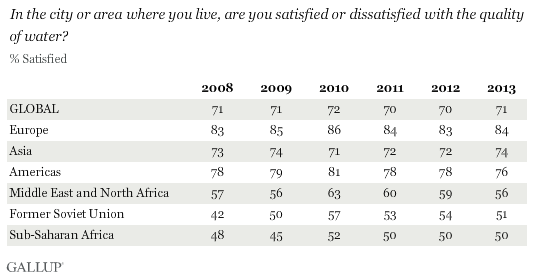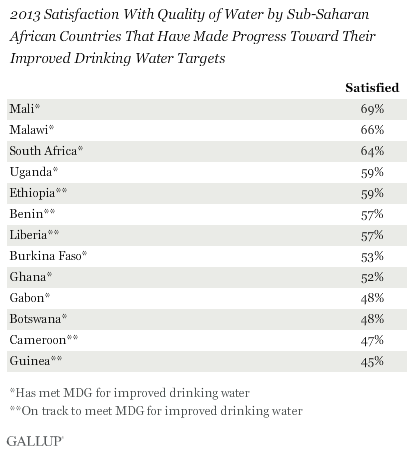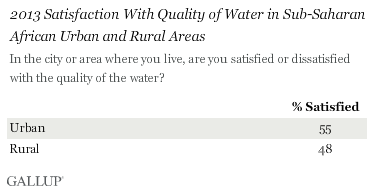WASHINGTON, D.C. -- Satisfaction with the quality of the water in the city or area where they live remained relatively high for residents in most parts of the world in 2013. More than seven in 10 worldwide are content with the quality of their water -- in line with what Gallup has measured since 2008. But satisfaction remains stubbornly low in sub-Saharan Africa, as the region attempts to meet the U.N.'s 2015 Millennium Development Goal (MDG) of halving the number of people without access to improved drinking water sources.

In lieu of substantial progress toward reaching that goal, half (50%) of residents of sub-Saharan African are satisfied with the quality of their water, essentially the same as in 2008 (48%). Satisfaction is similarly low among residents of countries in the former Soviet Union, where 51% are satisfied with their water quality, but their satisfaction is higher than what it was six years ago (42%). This is a more developed region where most countries have met or are on track to meet their MDG by 2015. Complete 2013 results by country can be found on page 2.
According to the World Health Organization's Progress on Drinking Water and Sanitation: 2014 Update, the lowest levels of drinking water coverage in the world are in sub-Saharan Africa, and most of those countries are not on track to meet MDG drinking water targets. Among nations in sub-Saharan Africa that have already met those objectives or are on track to do so by 2015 (and where Gallup has collected recent data), perceptions of water quality are still low compared with levels in more developed nations worldwide.
Perhaps surprisingly, residents in three countries in sub-Saharan Africa that have already met the targets -- South Africa, Ghana, and Botswana -- are less satisfied with the quality of their water in 2013 than they were in 2008. In 1990, the baseline year for MDG advancement, sub-Saharan Africa had, by far, the lowest drinking water coverage in the world -- which, combined with subsequent high population growth, has slowed progress in the region.

Urban-Rural Gap in Satisfaction With Water Quality
Fifty-five percent of sub-Saharan urban dwellers say they are satisfied with the quality of their water, compared with 48% in rural sectors. Most global progress in improved drinking water comes from people acquiring piped drinking water in their homes -- a less complicated undertaking in urban than in rural areas -- but progress in this endeavor has been slow in sub-Saharan Africa as a whole. However, even urbanites without piped drinking water are more likely than rural dwellers to have access to water kiosks, public taps, and protected wells and springs -- whereas those in rural areas depend primarily on unmanaged wells and springs or unimproved surface water from ponds and rivers for drinking and cooking.

Bottom Line
Although perceptions of water quality in sub-Saharan Africa have not improved -- and many countries in the region are not on track to meet the MDG for drinking water -- there has been significant progress. Twenty-four percent of the current population has gained access to improved drinking water since 2000, but such progress is likely occurring too slowly to positively affect sub-Saharan Africans' opinions about their water quality year over year.
For more complete methodology and specific survey dates, please review Gallup's Country Data Set details.
Survey Methods
Results are based on telephone and face-to-face interviews with 1,000 adults, aged 15 and older, conducted in 138 countries in 2013. For results based on the total sample of national adults, one can say with 95% confidence that the maximum margin of sampling error ranged from a low of ±2.1 percentage points to a high of ±5.6 percentage points. The margin of error reflects the influence of data weighting. In addition to sampling error, question wording and practical difficulties in conducting surveys can introduce error or bias into the findings of public opinion polls.


